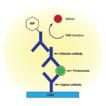-
Determination of 20S proteasome levels in biological samples (cell lysates, tissue extracts, plasma, serum)
-
Comparison of 20S proteasome levels in plasma/serum samples associated with a particular disease/illness with samples from healthy controls
-
Investigation of variation in 20S proteasome levels in abnormal cell lines/tissues
This kit provides the means to quantify 20S proteasome concentrations in biological samples using a sandwich ELISA technique, utilizing two 20S proteasome specific antibodies for capture and detection purposes together with a highly sensitive substrate. Sample 20S proteasome levels are determined by comparison to a 20S proteasome calibration curve produced in parallel. This kit provides sufficient material for 1x96 well plate set-up to be run.

The ELISA plate is coated with the capture antibody and the proteasome sample is added and allowed to complex with the bound antibody. The detection antibody is then added, followed by the secondary antibody. Subsequent reaction between the activated TMB substrate/chromogen complex and horseradish peroxidase (HRP) conjugated secondary antibody produces a blue colored solution. After reaching the desired color intensity, the reaction is terminated by addition of the stop solution, which changes the solution color from blue to yellow. The plate is then analyzed at 450nm using a UV-Vis spectrophotometric plate reader.
Please mouse over
Product Details
| Assay Time: | <3.5 hours |
| |
| Applications: | ELISA
|
| |
| Application Notes: | For quantification of 20S proteasome levels in biological samples noting that the kit is not suitable for mouse or rat samples. |
| |
| Wavelength: | 450 nm |
| |
| Species reactivity: | Human
|
| |
| Quantity: | 96 wells (24 tests in triplicate) |
| |
| Use/Stability: | Stable for up to six months from receipt when stored at -20°C. |
| |
| Handling: | Avoid freeze/thaw cycles. |
| |
| Shipping: | Blue Ice |
| |
| Long Term Storage: | -20°C |
| |
| Contents: | Plate, Capture Antibody, Detection Antibody, Conjugated Antibody, Proteasome Stock Solution, Binding Buffer, Wash Buffer, Blocking Buffer, ELISA Buffer, Lysis Buffer, TMB Substrate Solution, Stop Solution |
| |
| Scientific Background: | Proteasomes are non-lysosomal proteolytic complexes localised primarily in the cytoplasm and in the nucleus of eukaryotic cells. The 26S proteasome structure is composed of a 20S proteasome catalytic core complex and one or two 19S regulatory subcomplexes. The 20S core comprises two copies of 14 subunits (7 α-subunits and 7 β-subunits) arranged in a α7β7β7α7 cylindrical array. Varying catalytic subunit composition (β1, β1i; β2, β2i; β5, β5i) results in a variety of possible subtypes. The 19S regulatory subcomplexes, comprised of 6 ATPase and at least 10 non-ATPase subunits, specifically bind ubiquitinylated proteins and provide the 20S core with an ATP-ubiquitin–dependent proteolytic activity. The ubiquitin-proteasome system is the major non-lysosomal system for the degradation of short half-life proteins and peptides that are involved in basic cellular processes, such as cell-cycle regulation and apoptosis, transcriptional regulation, or antigen processing. Thus, protein degradation by the ubiquitin-proteasome pathway has a major regulatory function for proliferation activity and survival of both normal and malignant cells. The 20S proteasome has been detected in normal human blood plasma (known as circulating proteasome), possessing comparatively low specific activity and with a distinct pattern of subtypes. Proteasomes are often overexpressed in cancer cells; abnormally high expression of proteasomes having been found in human leukaemia cells, renal cancer cells and in breast cancer cell lines. In patients suffering from auto-immune diseases, malignant myelo-proliferative syndromes, multiple myeloma, acute and chronic lymphatic leukaemia, solid tumour, sepsis or trauma, the concentration of circulating proteasome has been found to be elevated, to correlate with the disease state, and may have prognostic significance. Proteasome levels have been measured by enzyme-linked immunosorbent assay (ELISA) techniques in cell lysates, serum or plasma samples. This approach has been used to show that proteasome concentrations in peripheral blood are elevated in patients with certain types of malignant diseases, including multiple myeloma, suggesting that circulating proteasome levels may be correlated with tumour burden. The link between elevated circulating proteasome levels and disease activity has also been demonstrated in patients with systemic autoimmune diseases. |
| |
| Regulatory Status: | RUO - Research Use Only |
| |
| Compatibility: | This product is compatible with the Absorbance 96 Plate Reader.
 |
| |
Product Literature References
Amniotic Fluid Proteasome and Immunoproteasome in the Setting of Intra-Amniotic Infection, Inflammation, and Preterm Birth: C.A. Ware, et al.; Reprod Sci.
28, 2562 (2021),
Abstract;
Clinical Relevance of Elevated Soluble ST2, HSP27 and 20S Proteasome at Hospital Admission in Patients with COVID-19: R. Wendt, et al.; Biology
10, 1186 (2021),
Abstract;
Serum 20S proteasome levels are associated with disease activity in MPO-ANCA-associated microscopic polyangiitis: H. Maruyama, et al.; BMC Rheumatol.
4, 36 (2020),
Abstract;
Full Text
Proteasome levels and activity in pregnancies complicated by severe preeclampsia and hemolysis, elevated liver enzymes, and thrombocytopenia (HELLP) syndrome: K. Berryman, et al.; Hypertension
73, 1308 (2019),
Application(s): ELISA using human plasma,
Abstract;
Genes related to maintenance of autophagy and successful aging: C.F. Chaves, et al.; Arq. Neuropsiquiatr.
76, 831 (2018),
Abstract;
Anti-ageing properties of Khelma Longevity™: treatment of human fibroblasts increases proteasome levels and decreases the levels of oxidized proteins: K. Voutetakis, et al.; N. Biotechnol.
38(Pt A), 36 (2017),
Abstract;
High Levels of Serum Ubiquitin and Proteasome in a Case of HLA-B27 Uveitis: S. Rossi, et al.; Int. J. Mol. Sci.
18, 505 (2017),
Abstract;
Full Text
Early detection of hepatocellular carcinoma co-occurring with hepatitis C virus infection: A mathematical model: A.N. Zekri, et al.; World J. Gastroenterol.
22, 4168 (2016),
Application(s): Measured proteasome levels,
Abstract;
Full Text
Interaction of proteasomes and complement C3, assay of antisecretory factor in blood: I. Lönnroth, et al.; J. Immunoassay. Immunochem.
37, 43 (2016),
Application(s): ELISA using human plasma,
Abstract;
Circulating 20S Proteasome Is Independently Associated with Abdominal Muscle Mass in Hemodialysis Patients: H. Fukasawa, et al.; PLoS One
10, e0121352 (2015),
Application(s): ELISA using human plasma,
Abstract;
Full Text
Particulate cytoplasmic structures with high concentration of ubiquitin-proteasome accumulate in myeloid neoplasms: A. Pecci, et al.; J. Hematol. Oncol.
8, 71 (2015),
Application(s): ELISA using human plasma,
Abstract;
Full Text
Serum biomarkers for early detection of hepatocellular carcinoma associated with HCV infection in egyptian patients: A.R. Zekri, et al.; Asian Pac. J. Cancer Prev.
16, 1281 (2015),
Application(s): ELISA using human serum,
Abstract;
Full Text
Coordinated regulation of protein synthesis and degradation by mTORC1: Y. Zhang, et al.; Nature
513, 440 (2014),
Application(s): ELISA using MEF cell lysate,
Abstract;
Juvenile Idiopathic Arthritis Subtype- and Sex-specific Associations with Genetic Variants in the PSMA6/PSMC6/PSMA3 Gene Cluster: T. Sjakste, et al.; Pediatr. Neonatol.
55, 393 (2014),
Application(s): ELISA using human plasma,
Abstract;
Glutathione peroxidase-1 primes pro-inflammatory cytokine production after LPS challenge in vivo: S. Bozinovski, et al.; PLoS One
7, e33172 (2012),
Application(s): ELISA using murine BALF,
Abstract;
Full Text
The prognostic impact of circulating proteasome concentrations in patients with epithelial ovarian cancer: M. Heubner, et al.; Gynecol. Oncol.
120, 233 (2011),
Abstract;
Cancer cachexia: traditional therapies and novel molecular mechanism-based approaches to treatment: N.B. Kumar, et al.; Curr. Treat. Options Oncol.
11, 107 (2010),
Application(s): ELISA using human plasma,
Abstract;
Full Text
General Literature References
Phase I trial of induction histone deacetylase and proteasome inhibition followed by surgery in non-small-cell lung cancer.: D.R. Jones, et al.; J. Thorac. Oncol.
11, 1683 (2012),
Abstract;
Extracellular, circulating proteasomes and ubiquitin - incidence and relevance: S.U. Sixt & B. Dahlmann; Biochim. Biophys. Acta
1782, 817 (2008),
Abstract;
Immunological methods to quantify and characterize proteasome complexes: development and application: M. Majetschak & L.T. Sorell; J. Immunol. Methods
334, 91 (2008),
Abstract;
Circulating proteasome levels are an independent prognostic factor for survival in multiple myeloma: C. Jakob, et al.; Blood
109, 2100 (2007),
Abstract;
Protein degradation by the ubiquitin-proteasome pathway in normal and disease states: S.H. Lecker, et al.; J. Am. Soc. Nephrol.
17, 1807 (2006),
Abstract;
High plasma proteasome levels are detected in patients with metastatic malignant melanoma: P.E. Stoebner, et al.; Br. J. Dermatol.
152, 948 (2005),
Abstract;
Circulating proteasomes are markers of cell damage and immunologic activity in autoimmune diseases: K. Egerer, et al.; J. Rheumatol.
29, 2045 (2002),
Abstract;
Role and function of the 26S proteasome in proliferation and apoptosis: C. Naujokat & S. Hoffmann; Lab. Invest.
82, 965 (2002),
Abstract;
Antigen processing by the proteasome: P.M. Kloetzel; Nat. Rev. Mol. Cell Biol.
2, 179 (2001),
Abstract;
Plasma proteasome level is a potential marker in patients with solid tumors and hemopoietic malignancies: T. Lavabre-Bertrand, et al.; Cancer
92, 2493 (2001),
Abstract;
Reconstitution of hybrid proteasomes from purified PA700-20 S complexes and PA28alphabeta activator: ultrastructure and peptidase activities: F. Kopp, et al.; J. Mol. Biol.
313, 465 (2001),
Abstract;
Increased prosomal proteins in breast cancer cells and in neighboring normal cells in Parsi and non-Parsi populations: A. Bhui-Kaur, et al.; J. Cancer Res. Clin. Oncol.
124, 117 (1998),
Abstract;
The 26S proteasome: subunits and functions: K. Tanaka & C. Tsurumi; Mol. Biol. Rep.
24, 3 (1997),
Abstract;
Structure and functions of the 20S and 26S proteasomes: O. Coux, et al.; Annu. Rev. Biochem.
65, 801 (1996),
Abstract;
Serum concentration and localization in tumor cells of proteasomes in patients with hematologic malignancy and their pathophysiologic significance: M. Wada, et al.; J. Lab. Clin. Med.
121, 215 (1993),
Abstract;
Changes in expressions of proteasome and ubiquitin genes in human renal cancer cells: H. Kanayama, et al.; Cancer Res.
51, 6677 (1991),
Abstract;
Abnormally high expression of proteasomes in human leukemic cells: A. Kumatori, et al.; PNAS
87, 7071 (1990),
Abstract;
Related Products














